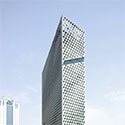Height rank
Fortune Center
Guangzhou
-
Metrics
You must be a CTBUH Member to view this resource.
Official Name
Fortune Center
Other Names
Pearl River New City B2-10 project, Yuexiu Financial Tower
Type
Building
Status
Completed, 2015
Country
City
Address
Function
A mixed-use tall building contains two or more functions (or uses), where each of the functions occupy a significant proportion of the tower's total space. Support areas such as car parks and mechanical plant space do not constitute mixed-use functions. Functions are denoted on CTBUH "Tallest Building" lists in descending order, e.g., "hotel/office" indicates hotel function above office function.
office
Structural Material
Both the main vertical/lateral structural elements and the floor spanning systems are constructed from steel. Note that a building of steel construction with a floor system of concrete planks or concrete slab on top of steel beams is still considered a “steel” structure as the concrete elements are not acting as the primary structure.
Reinforced Concrete
Both the main vertical/lateral structural elements and the floor spanning systems are constructed from concrete which has been cast in place and utilizes steel reinforcement bars.
Precast Concrete
Both the main vertical/lateral structural elements and the floor spanning system are constructed from steel reinforced concrete which has been precast as individual components and assembled together on-site.
Mixed-Structure
Utilizes distinct systems (e.g. steel, concrete, timber), one on top of the other. For example, a steel/concrete indicates a steel structural system located on top of a concrete structural system, with the opposite true of concrete/steel.
Composite
A combination of materials (e.g. steel, concrete, timber) are used together in the main structural elements. Examples include buildings which utilize: steel columns with a floor system of reinforced concrete beams; a steel frame system with a concrete core; concrete-encased steel columns; concrete-filled steel tubes; etc. Where known, the CTBUH database breaks out the materials used in a composite building’s core, columns, and floor spanning separately.
composite
Height
309.4 m / 1,015 ft
Floors Above Ground
68
Floors Below Ground
4
Tower GFA
210,477 m² / 2,265,556 ft²
-
By function
You must be a CTBUH Member to view this resource.
-
By material
You must be a CTBUH Member to view this resource.
Architect
The Collaborative Architect is an additional organization that is brought in, usually at the request of either the client or the main design architect, to collaborate on the design of the building.
MEP Engineer
Other Consultant
Other Consultant refers to other organizations which provided significant consultation services for a building project (e.g. wind consultants, environmental consultants, fire and life safety consultants, etc).
Other Consultant refers to other organizations which provided significant consultation services for a building project (e.g. wind consultants, environmental consultants, fire and life safety consultants, etc).
You must be a CTBUH Member to view this resource.
Developer
Yuexiu Real Estate Investment Trust
Architect
The Collaborative Architect is an additional organization that is brought in, usually at the request of either the client or the main design architect, to collaborate on the design of the building.
MEP Engineer
Other Consultant
Other Consultant refers to other organizations which provided significant consultation services for a building project (e.g. wind consultants, environmental consultants, fire and life safety consultants, etc).
Other Consultant refers to other organizations which provided significant consultation services for a building project (e.g. wind consultants, environmental consultants, fire and life safety consultants, etc).
CTBUH Initiatives
CTBUH Releases Year in Review: Tall Trends of 2015
19 January 2016 - CTBUH Journal
Videos

19 October 2016 | Guangzhou
Local Urbanism - High-Rise Building Design in the Development of High Density Cities
This project is located in the Tianhe district of Guangzhou, which is the area with the highest density in the city. There are Linhe village...
Research
Ermell_ccbysa.jpg)
19 January 2016
Year in Review: Tall Trends of 2015
Jason Gabel, Marty Carver & Marshall Gerometta, CTBUH
CTBUH has determined that 106 buildings of 200 meters’ height or greater were completed around the world in 2015 – setting a new record for...
About Fortune Center
Located in Guangzhou’s Pearl River New City Development, Fortune Center is sited across the street from a large central park above a subterranean shopping mall which serves as the center piece of the city’s premiere central business district. The tower has a bowed form to provide a distinction between it and other office towers with a more rigid form and meets the ground with a public plaza rather than being perched upon a podium as is typical with tall buildings in China.
The tower footprint is rotated 30 degrees relative to the street network to minimize reflective glare on the tower’s southern exposure while maximizing views and creating a mirrored relationship to the Pearl River Tower, located across the park to the west and standing in at the same height. Fortune Center features a number of green design concepts including an on-site chiller plant creating ice in the evening hours and using the chilled water in the climate control system, reducing overall energy usage.
The Fortune Center was rises from a 4 story basement stretching across the site into a composite structure framed with a reinforced concreted core and a perimeter of large hallow steel columns. The corners feature large box columns framing the edges of a truss network which runs vertically along both of tower’s narrower ends. The column free office floorplates are then framed in steel as well and attach the outer perimeter of columns to the tower’s core. The entire exterior is then clad with a glass curtain wall façade.
The Fortune Center’s location alongside the center of the Pear River New City Development will ensure the tower remains a highly visible fixture on Guangzhou’s rapidly changing skyline.
Subscribe below to receive periodic updates from CTBUH on the latest Tall Building and Urban news and CTBUH initiatives, including our monthly newsletter. Fields with a red asterisk (*) next to them are required.
View our privacy policy














